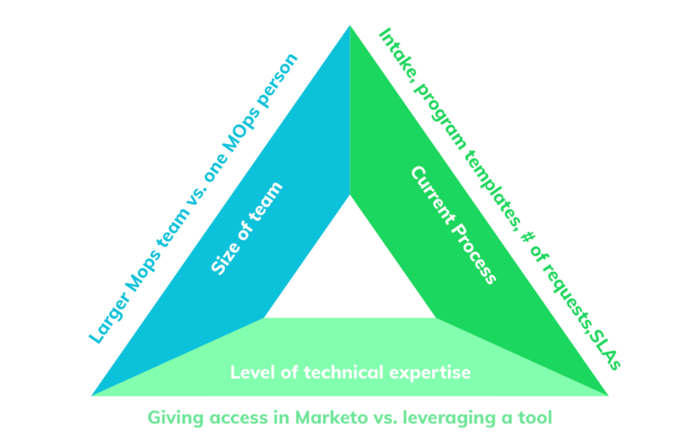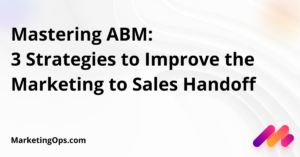No two organizations approach campaign execution the same way. Some may view campaign execution as on-off emails and batch and blast sends, while for others, it’s more landing pages that support digital and in-person events and ebooks. At the end of the day, campaign execution is a wide-ranging term that encompasses all the campaign-focused work your team is doing to generate activity and ultimately, get leads into the funnel.
As a Marketo consultancy, we see all sorts of approaches to campaign execution, with the three key approaches being centralized, decentralized, and hybrid. But how do you know which approach is right for your organization? We decided to bring together two marketing operations experts to hear their perspectives on each type of approach, and why a new “centralized-ish” approach may be the new standard for scaling Marketo campaigns.
Britney Young, Marketing Operations Manager at McKesson, and Amanda Giacobassi, Senior Director of Marketing Operations Solutions at MERGE, covered this topic during last month’s webinar hosted by MERGE and marketingops.com.
💡 Want to watch the recorded webinar? Watch here!
The centralized approach
In a centralized approach, marketers are responsible for building programs in Marketo. This is someone who wears a lot of hats – they are coming up with the content, visuals, creatives, etc.
This person is also responsible for building out the emails in the designated MAP and scheduling themselves. This approach often works well with smaller teams or when you have a simple tech stack where one person can oversee all actions.
The hybrid approach
The hybrid approach is the middle ground where you still have a specialization, i.e. marketers who are going in and making requests and marketing operations professionals who are managing the email service platform, but you also have technology in the middle to help filter and triage requests.
This ensures that by the time a marketing operations professional is looking at the request, everything is buttoned up and ready to go. This is the nexus of the centralized-ish approach
The decentralized approach
In a decentralized approach, marketing operations professionals are responsible for executing all campaign requests. This approach is more suitable for larger teams who have a breakout and specialization of roles.
In this approach, you’ll have marketers who are requesting the campaigns. The marketer is thinking about the strategy of the campaign, possibly writing the copy of the campaign, but ultimately they are handing off the design elements and execution to others with specialized skills on their team.
A decentralized approach works well in concept, but too often with this approach, the marketing operations team becomes a bottleneck. This is because you always have a fraction of the marketing operations staff as you do the rest of the campaign staff.
We often see that a decentralized approach is necessary with larger teams that are challenging to manage. This is exactly why process documents and SLAs and templates are important! Without these, you’ll accumulate a backlog of execution requests and without a buttoned-up process and set of templates, it becomes frustrating for everyone around.
But wait… there’s a new player in town!
Meet “centralized-ish,” a new approach to campaign execution where marketing operations professionals can keep control of branding, data, governance, process, and organization in Marketo, while stakeholders still have the autonomy to submit and create campaigns as needed.
This allows marketing operations professionals to focus on strategic initiatives and optimization, while stakeholders can meet the demands of an agile marketplace, ultimately leading to fewer bottlenecks for requests and faster speed to execution.
Before you move to a centralized-ish approach, you’ll need to think through a few things.
Considerations when moving forward to a centralized-ish approach

It’s crucial to have a centralized way in which the requests are coming to your team. That’s why you’ll want to nail down a solid intake process whether that’s using a project management tool or some sort of request form.
In your marketing automation platform, having program templates built out or any type of SLA with stakeholders will be useful to have in place.
You should also assess the number of requests that you receive – you might not have to move all requests to a centralized-ish approach – that’s why it’s helpful to know the number of requests – is it one-off emails or is it more nurture and webinar emails?
There are a few different ways you can look at the centralized-ish approach:
- Is your team tech-savvy? You may be able to leverage the roles and permissions already in Marketo and still give access to marketers.
- Leverage third-party tools that would sit on top of Marketo to give marketers access to Marketo without actually letting them in Marketo (Jeto is a great example).
Another key component of switching to a centralized-ish approach is the change management aspect. Your team may be nervous or skeptical about this new approach, and everyone has different fears, such as:
- Marketo admins: Nervous about giving access to others in Marketo
- Content managers: Hesitant to learn a new tool
- Campaign operations managers: Worried about their jobs being replaced by automation
To address these fears, consider scheduling one-on-one meetings with team members to allow team members to openly talk about their fears and hesitations.
A centralized-ish case study
At Mckesson, Britney and her team support 12+ business units with varying types of requests – some are more urgent and need to be sent out at a specific time, while others are less time-sensitive. Britney has four campaign operations specialists that are the ones churning out these emails.
Eventually, it got to the point where her team felt like they were getting an influx of requests, and trying to accommodate these requests got more challenging as time went on.
Landing on a Centralized-ish Approach
Britney began looking at tools that sit on top of Marketo to keep untrained users out of Marketo yet still allow stakeholders to make requests and create email campaigns.
Here was her criteria for finding a solution to support a centralized-ish approach:
- How does it integrate with MAP like Marketo?
- Is there flexibility to support multiple branding styles?
- Is the interface user-friendly?
- Does it fit within the budget?
- Is there customer support for onboarding and launch?
- Are there training and resources available to help the team?
Britney’s team landed on Jeto due to the seamless integration with Marketo and how easy onboarding and training were. Within a week, Britney felt comfortable demoing and training her team. Best of all, Jeto solved the centralized-ish approach that her team was looking for.

Curious to learn more about Jeto? Learn more here!









